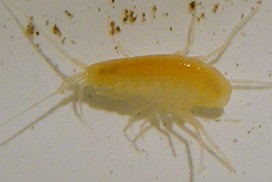
Stygobromus is a genus of amphipod crustaceans that live in subterranean habitats. The majority of the listed species are endemic to North America, a smaller number of species are also known from Eurasia. Most of the North American species live in areas which were not covered by the Laurentide Ice Sheet, although a few species seem to have survived under the ice. A number of species are on the IUCN Red List as endangered species (EN) or vulnerable species (VU); one species, S. lucifugus, is extinct.
Stygobromus barri, commonly called Barr's cave amphipod, is a troglomorphic species of amphipod in family Crangonyctidae. It is endemic to Missouri in the United States.

Stygobromus bifurcatus, the bifurcated cave amphipod, is a troglomorphic species of amphipod in family Crangonyctidae. It is endemic to Texas in the United States.
Stygobromus bowmani, commonly called Bowman's cave amphipod, is a troglomorphic species of amphipod in family Crangonyctidae. It is endemic to Oklahoma in the United States.
Stygobromus clantoni, commonly called Clanton's cave amphipod, is a troglomorphic species of amphipod in family Crangonyctidae. It is native to Kansas and Missouri in the United States.
Stygobromus conradi, commonly called Burnsville Cove cave amphipod, is a troglomorphic species of amphipod in family Crangonyctidae. It is endemic to Virginia in the United States.
Stygobromus cooperi, commonly called Cooper's cave amphipod, is a troglomorphic species of amphipod in family Crangonyctidae. It is endemic to a single cave, Silers cave in Berkeley County, West Virginia in the United States.
Stygobromus dejectus, commonly called Cascade Cave amphipod, is a troglomorphic species of amphipod in family Crangonyctidae. It is endemic to Texas in the United States.
Stygobromus ephemerus, commonly called ephemeral cave amphipod, is a troglomorphic species of amphipod in family Crangonyctidae. It is endemic to Virginia in the United States.
Stygobromus flagellatus, commonly called Ezell's Cave amphipod, is a troglomorphic species of amphipod in family Crangonyctidae. It is endemic to Texas in the United States.
Stygobromus hadenoecus, commonly called Devil's Sinkhole amphipod, is a troglomorphic species of amphipod in family Crangonyctidae. It is endemic to Texas in the United States.
Stygobromus longipes, commonly called long-legged cave amphipod, is a troglomorphic species of amphipod in family Crangonyctidae. It is endemic to Texas in the United States.
Stygobromus mackenziei, commonly called Mackenzie's cave amphipod, is a troglomorphic species of amphipod in family Crangonyctidae. It is endemic to California, where it occurs only in Empire Cave. This cave is part of the Porter Caves, in the grounds of University of California, Santa Cruz.
Stygobromus mundus, commonly called Bath County cave amphipod, is a troglomorphic species of amphipod in family Crangonyctidae. It is endemic to Bath County, Virginia in the United States.
Stygobromus parvus, commonly called the minute cave amphipod, is a troglomorphic species of amphipod in family Crangonyctidae. It is endemic to West Virginia in the United States.

Stygobromus pecki, the Peck's cave amphipod, is a rare species of crustacean found in four cavern areas of southwestern Texas in the United States. It is a federally listed endangered species in the United States and is also listed as Endangered on the IUCN Red List. Because of the species' limited geographical distribution, not much information on S. pecki is known. As of April 2022, there is no available 5-year review, Species Status Assessment, or recovery plan for the species. However, the Edwards' Aquifer Habitat Conservation Program (EAHCP), with the support of the U.S. Fish and Wildlife Service (UFWS), has been attempting to further study and promote conservation of S. pecki.
Stygobromus pizzinii, commonly called Pizzini's cave amphipod, is a troglomorphic species of amphipod in family Crangonyctidae. It is native to District of Columbia, Maryland, Pennsylvania and Virginia in the United States.
Stygobromus reddelli, commonly called Reddell's cave amphipod or Reddell's stygobromid, is a troglomorphic species of amphipod in family Crangonyctidae. It is endemic to Texas in the United States.
Stygobromus subtilis, commonly called the subtle cave amphipod, is a troglomorphic species of amphipod in family Crangonyctidae. It is native to Illinois, Michigan and Missouri in the United States.
Stygobromus wengerorum, commonly called Wenger's cave amphipod, is a troglomorphic species of amphipod in family Crangonyctidae. It is endemic to two caves in Mariposa County, California in the United States.




